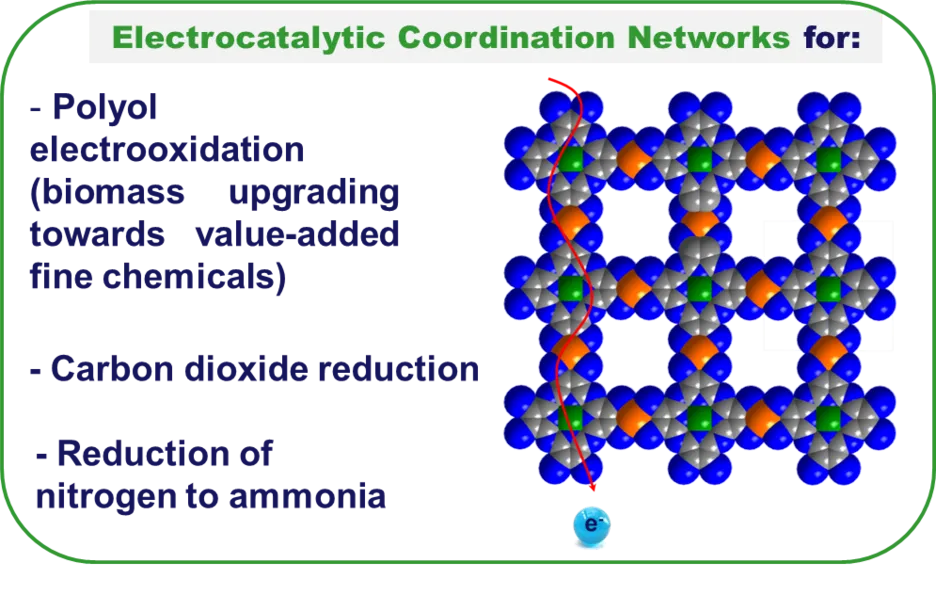| Consortium: | |
| Prof. Dr. Stefan Kaskel, Dresden Technische Universität Dresden Anorganische Chemie I | |
| Prof. Dr. Xinliang Feng, Dresden Technische Universität Dresden Molekulare Funktionsmaterialien | |
| Prof. Dr. Eike Brunner, Dresden Technische Universität Dresden Fakultät für Chemie und Lebensmittelchemie, Lehrstuhl für Bioanalytische Chemie | |
| Project: | Electrocatalytic Coordination Networks |
| Abstract: | Porous coordination networks (PCNs) are ideal candidates for selective electrocatalytic transformations since they enable highly selective adsorptive separations of small molecules inside pores and at the same time the integration of catalytically active sites, originating from transition metals as nodes or dopants generating tunable redox functions as building blocks in electrocatalytic coordination networks. PCNs developed in the 1st funding phase perform as highly active and selective electrocatalysts, however limitations in electrical conductivity for established CN systems and the instability of some CNs towards aqueous electrolytes reveal the need for exploring the synthesis of new PCN electrocatalysts. As a technical challenge, processing such materials into thin film electrodes is a key requirement to achieve high performance catalysts. Electrocatalysis for the generation of valuable intermediates poses a huge potential for the use of low-cost electrical energy emerging from the fluctuating energy supply of renewable resources. Electrocatalytic reduction of greenhouse gases such as CO2 (CO2RR) and conversion into valuable fuels such as methanol and methane is a promising target. Electroreduction of N2 (NRR) is a visionary target to reduce energy consumption for fertilizer production. Moreover a high potential of highly selective CNs is anticipated for fine chemical intermediates, for example the selective oxidation of polyols derived from biomass. This project will develop the next generation of electronically conductive coordination networks (ECNs) and their integration into electrodes for electrocatalysis where the CN enhances the product selectivity and the electron transfer is realized either by the I) coordination network itself, or II) a catalytically active nanomaterial using a composite approach. In an interdisciplinary approach the project will cover the whole process chain from the design and synthesis of molecular building blocks, ECN synthesis, development of required processing and advanced in situ-characterization techniques towards function demonstration in selected electrocatalytic model reactions including, CO2 and N2 electroreduction and polyol electrooxidation for the production of fine chemicals. |
| Publications: | |
| R. Dong, Z. Zheng, D. C. Tranca, J. Zhang, N. Chandrasekhar, S. Liu, X. Zhuang, G. Seifert, X. Feng “Immobilizing Molecular Metal Dithiolene–Diamine Complexes on 2D Metal–Organic Frameworks for Electrocatalytic H2 Production” Chem. Eur. J. 2017, 23, 2255-2260 DOI: 10.1002/chem.201605337 | |
| L. Borchardt, Q.-L. Zhu, M. E Casco, R. Berger, X. Zhuang, S. Kaskel, X. Feng, Q. Xu “Toward a molecular design of porous carbon materials” Mater. Today 2017, 20, 592-610 DOI: 10.1016/j.mattod.2017.06.002 | |
| W. Ju, A. Bagger, G.-P. Hao, A. S. Varela, I. Sinev, V. Bon, B. Roldan Cuenya, S. Kaskel, J. Rossmeisl, P. Strasser “Understanding activity and selectivity of metal-nitrogen-doped carbon catalysts for electrochemical reduction of CO2” Nat. Commun. 2017, 8, 944 DOI: 10.1038/s41467-017-01035-z | |
| R. Dong, P. Han, H. Arora, M. Ballabio, M. Karakus, Z. Zhang, C. Shekhar, P. Adler, P. S. Petkov, A. Erbe, S. C. B. Mannsfeld, C. Felser, T. Heine, M. Bonn, X. Feng, E. Canovas “High-Mobility Band-Like Charge Transport in a Semiconducting Two-Dimensional Metal–Organic Framework” Nat. Mater. 2018, 17, 1027-1032 DOI: 10.1038/s41563-018-0189-z | |
| G. Chen, J. Zhang, F. Wang, L. Wang, Z. Liao, E. Zschech, K. Müllen, X. Feng “Cobalt-Based Metal–Organic Framework Nanoarrays as Bifunctional Oxygen Electrocatalysts for Rechargeable Zn-Air Batteries” Chem. Eur. J. 2018, 24, 18413-18418 DOI: 10.1002/chem.201804339 | |
| H. Bunzen, F. Kolbe, A. Kalytta-Mewes, G. Sastre, E. Brunner, D. Volkmer “Achieving large volumetric gas storage capacity in metal-organic frameworks by kinetic trapping: A case study of xenon loading in MFU-4” J. Am. Chem. Soc. 2018, 140, 10191-10197 DOI: 10.1021/jacs.8b04582 | |
| J. Zhang, G. Chen, K. Müllen, X. Feng „Carbon-Rich Nanomaterials: Fascinating Hydrogen and Oxygen Electrocatalysts” Adv. Mater. 2018, 30, 1800528 DOI: 10.1002/adma.201800528 | |
| R. Dong, Z. Zhang, D. C. Tranca, S. Zhou, M. Wang, P. Adler, Z. Liao, F. Liu, Y. Sun, W. Shi, Z. Zhang, E. Zschech, S. C. B. Mannsfeld, C. Felser, X. Feng “A coronene-based semiconducting two-dimensional metal-organic framework with ferromagnetic behavior” Nat. Commun. 2018, 9, 2637 DOI: 10.1038/s41467-018-05141-4 | |
| J. B. Richter, C. Eßbach, I. Senkovska, S. Kaskel, E. Brunner “Quantitative in situ 13C NMR studies of the electro-catalytic oxidation of ethanol” Chem. Commun. 2019, 55, 6042-6045 DOI: 10.1039/C9CC02660F | |
| C. Eßbach, I. Senkovska, T. Unmüssig, A. Fischer, S. Kaskel “Selective alcohol electrooxidation by ZIF-8 functionalized Pt/carbon catalyst” ACS Appl. Mater. Interfaces 2019, 11, 20915-20922 DOI: 10.1021/acsami.9b06122 | |
| S. Xu, G. Wang, B. P. Biswal, M. Addicoat, S. Paasch, W. Sheng, X. Zhuang, E. Brunner, T. Heine, R. Berger, X. Feng “A Nitrogen-Rich 2D sp2-Carbon-Linked Conjugated Polymer Framework as a High-Performance Cathode for Lithium-Ion Batteries” Angew. Chem. Int. Ed. 2019, 58, 849-853 DOI: 10.1002/anie.201812685 | |
| C. Yang, R. Dong, M. Wang, P. S. Petkov, Z. Zhang, M. Wang, P. Han, M. Ballabio, S. A. Bräuninger, Z. Liao, J. Zhang, F. Schwotzer, E. Zschech, H.-H. Klauss, E. Cánovas, S. Kaskel, M. Bonn, S. Zhou, T. Heine, X. Feng “A semiconducting layered metal-organic framework magnet” Nat. Commun. 2019, 10, 3260 DOI: 10.1038/s41467-019-11267-w | |
| H. Zhong, K. Hoang Ly, M. Wang, Y.Krupskaya, X. Han, J. Zhang, J. Zhang, V.Kataev, B. Büchner, I.M. Weidinger, S. Kaskel, P. Liu, M. Chen, R. Dong , X. Feng “Phthalocyanine-based layered two-Dimensional conjugated metal-organic framework as highly efficient electrocatalyst for oxygen reduction reaction” Angew. Chem. Int. Ed. 2019, 58, 10677-10682 DOI: 10.1002/anie.201907002 | |
| M. Wang, M. Ballabio, M. Wang, H.-H. Lin, B. P. Biswal, X. Han, S. Paasch, E. Brunner, P. Liu, M. Chen, M. Bonn, T. Heine, S. Zhou, E. Cánovas, R. Dong, X. Feng “Unveiling electronic properties in metal–phthalocyanine-based pyrazine-linked conjugated two-dimensional covalent organic frameworks” J. Am. Chem. Soc 2019, 141, 16810-16816 DOI: 10.1021/jacs.9b07644 |
